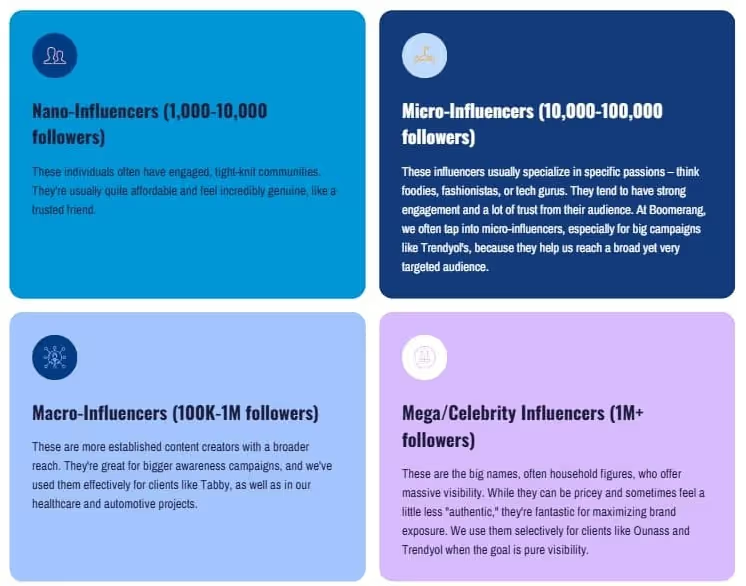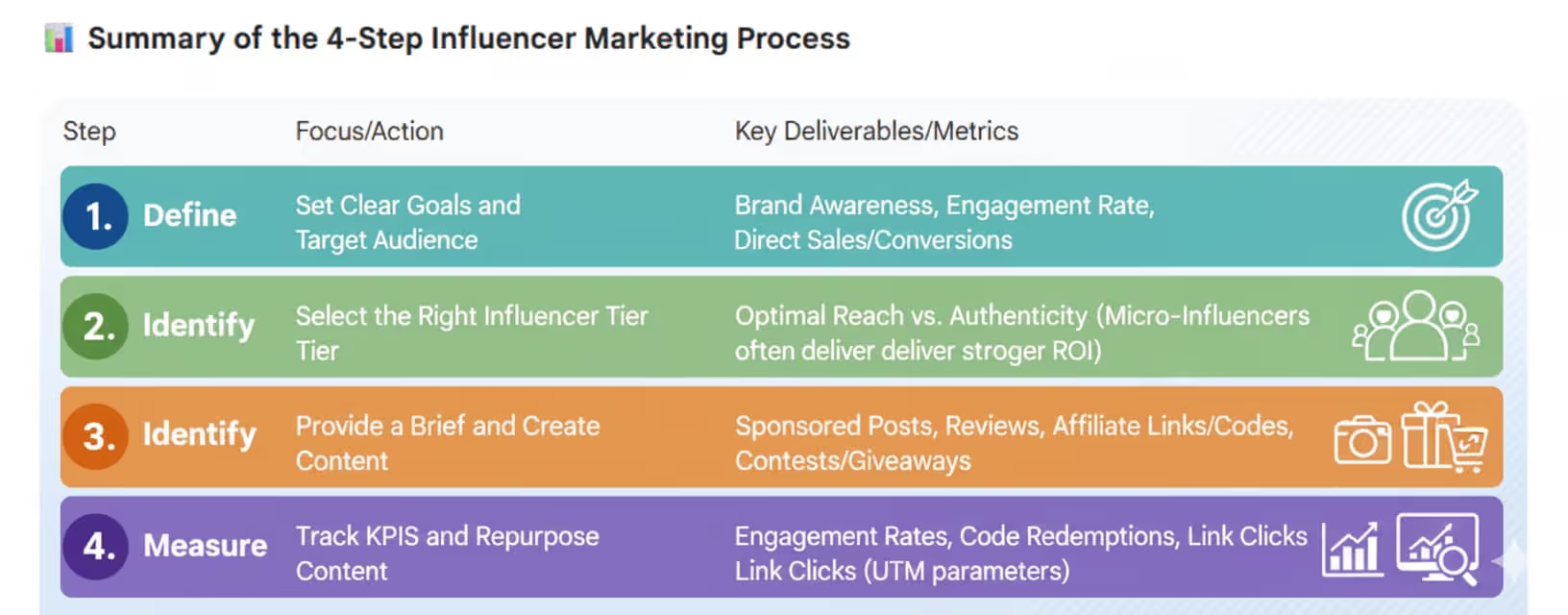What is Influencer Marketing? The Definitive Guide for Modern Brands 🚀

Influencer marketing has transformed from a niche tactic to a cornerstone of modern digital strategy. But What is Influencer Marketing?
Define Influencer Marketing: Beyond the Buzzword
Influencer marketing is a collaboration between a brand and an influencer (a person who has established credibility and an engaged audience on social media) to promote a product or service.
Influencer marketing usually focuses on real, relatable voices who have earned trust in a certain niche, unlike celebrity endorsements.
This lets brands get around ad blockers and the growing distrust of traditional advertising by going straight to communities that trust recommendations from friends.
Simply put, you are leveraging an influencer's audience, content creation skill, and most importantly, their established trust to tell your brand's story.
The Numbers Behind the Market (Why It Matters)
The effectiveness of this channel is undeniable, with the industry valued at an estimated $24 billion in 2024 and projected to grow further. Recent data shows that for every $1 spent on influencer marketing, businesses typically see a $5.78 return on investment (ROI). Furthermore, a significant majority—as high as 86% of consumers—report making a purchase inspired by an influencer at least once per year.
How Does Influencer Marketing Work? The 4-Step Process
A successful influencer marketing campaign follows a strategic, multi-step process designed to align brand goals with the influencer's creative vision.
Step 1: Define Your Goals and Audience
Before selecting a creator, a brand must clearly define its objectives. Are you aiming for Brand Awareness (e.g., reaching 1 million new users)? Engagement (e.g., increasing post comments by 30%)? Or Direct Sales/Conversions (e.g., generating 500 sales using a unique code)?
It's just as important to know who your target audience is. To choose an influencer whose followers fit your ideal customer perfectly, you need to know the demographics and psychographics of that customer.
Step 2: Identify the Right Creator Tier
People who follow influencers are usually grouped by how many followers they have, which often determines how far they can reach, how many people they can engage with, and how much they cost. Picking the right Influencer Tier is important for both the success of the campaign and the efficient use of the budget:

Pro Tip: While mega-influencers offer reach, Micro-Influencers often deliver the strongest ROI due to their highly engaged, specialized communities and perceived authenticity.
Step 3: Collaborate and Create the Content
Once the right creator is selected, the brand provides a detailed Campaign Brief. This document outlines key messaging, required hashtags, and a clear call-to-action (CTA) while allowing the influencer creative freedom.
The content can come in a lot of different forms, such as:
- Sponsored Posts: A photo, story, or Reel that is all about the product.
- Reviews and unboxings of products: honest, real-life demonstrations of a new product.
- Affiliate Marketing: Influencers promote a unique link or code, earning a commission on sales.
- Contests and Giveaways: Used to rapidly boost engagement and follower count.
Step 4: Measure and Amplify
Tracking Key Performance Indicators (KPIs) such as engagement rates, unique promo code redemptions, and link clicks (using UTM parameters) is the last phase.
Essentially, the most successful brands turn the influencer into an extension of their creative marketing team by repurposing the influencer's excellent content across their own channels.

The Core Benefits of Influencer Marketing for Brands
Partnering with influencers offers distinct advantages that traditional digital advertising often fails to match.
1. Instant Trust and Credibility
In a world full of ads, people want things that are real. An endorsement from an influencer is a form of social proof.
People are much more likely to believe a message from a brand if it comes from a creator they know and trust. This instant credibility makes it much faster for a brand to build trust with new customers.
2. Hyper-Targeted Audience Access
Influencers build very specific, niche audiences, like people who love sustainable fashion or people who review gaming hardware.
Working with an influencer who knows a lot about your field guarantees that your marketing message reaches the exact group of people most likely to be interested in your product. This level of precision is difficult to achieve with broad ad campaigns.
3. High-Quality, Authentic Content at Scale
The most important thing about influencers is that they make content. They know the best ways to use their platform, like what kinds of short videos do well on TikTok or what kinds of pictures get people interested on Instagram.
Brands can get the following by working together:
- Fresh Perspectives: Content that feels native to the platform, not like a corporate advertisement.
- Volume: The ability to scale content creation across multiple voices and channels simultaneously.
4. Improved Social Search and Discoverability
As more consumers use platforms like Instagram and TikTok as their primary search engines, an influencer's content organically boosts your brand's presence in social search results. When influencers tag your brand and use relevant hashtags, it improves your "Social SEO," making it easier for new customers to discover you.
The Future of Influencer Marketing
The industry is rapidly evolving, moving away from follower counts and towards quality of engagement and long-term partnerships. The key trends for agencies and brands today include:
- Focus on Long-Term Relationships: Brands are shifting from one-off sponsored posts to continuous, ambassador-style collaborations that deepen authenticity.
- AI Integration: Tools utilizing Artificial Intelligence are being used for better creator discovery, vetting for fake followers, and predicting campaign performance to maximize ROI.
- Short-Form Video Dominance: Platforms like TikTok and Instagram Reels continue to lead the way, making creative, fast-paced video the preferred format for collaboration.
If you're ready to harness the power of authentic influence and see proven results, partnering with an expert agency like Boomerang is the essential first step to navigating this complex, high-reward landscape.
Related Articles:
Influencer Marketing Strategy in Dubai: A Comprehensive Guide for 2025
Integrate Influencers, Affiliates, and Ambassadors for Full-Funnel Growth in the UAE & GCC
Influencer Marketing vs. Traditional Advertising: Maximizing ROI in Dubai
Boomerang: Your Field Expert in GCC Influencer Marketing
While global agencies manage reach, success in the Gulf requires deep, specialized local knowledge. Boomerang excels by focusing on the unique demands of the GCC market (UAE, Saudi Arabia, etc.):
- Regulation Compliance: We ensure every campaign strictly adheres to evolving local laws, such as the National Media Council (NMC) licensing requirements in the UAE, avoiding costly non-compliance issues.
- Cultural Nuance: We understand and respect local customs, languages, and sensitivities to ensure messaging is impactful and appropriate across different Gulf cities.
- Vetted Talent Network: We provide access to high-quality, pre-qualified local talent, ensuring authentic engagement and maximum ROI from your regional campaigns.
We transform the complexity of the Gulf market into a competitive advantage for your brand.
Ready to Maximize Your ROI in the Middle East?
Don't let complex regulations or cultural gaps slow your growth. Contact Boomerang today for a tailored consultation and see how our deep GCC expertise can deliver measurable success for your next influencer campaign.
Real Case Studies: Influencer Marketing Success in the Middle East
 The campaign activated 10 UAE national influencers, achieved significant social media engagement uplift, and directly increased Chić's in-store inquiries and footfall.
The campaign activated 10 UAE national influencers, achieved significant social media engagement uplift, and directly increased Chić's in-store inquiries and footfall. Discover how American Express achieved remarkable success for its Platinum Card, generating over 24 million views and significant engagement through a luxurious Al Ula experience.
Discover how American Express achieved remarkable success for its Platinum Card, generating over 24 million views and significant engagement through a luxurious Al Ula experience.






